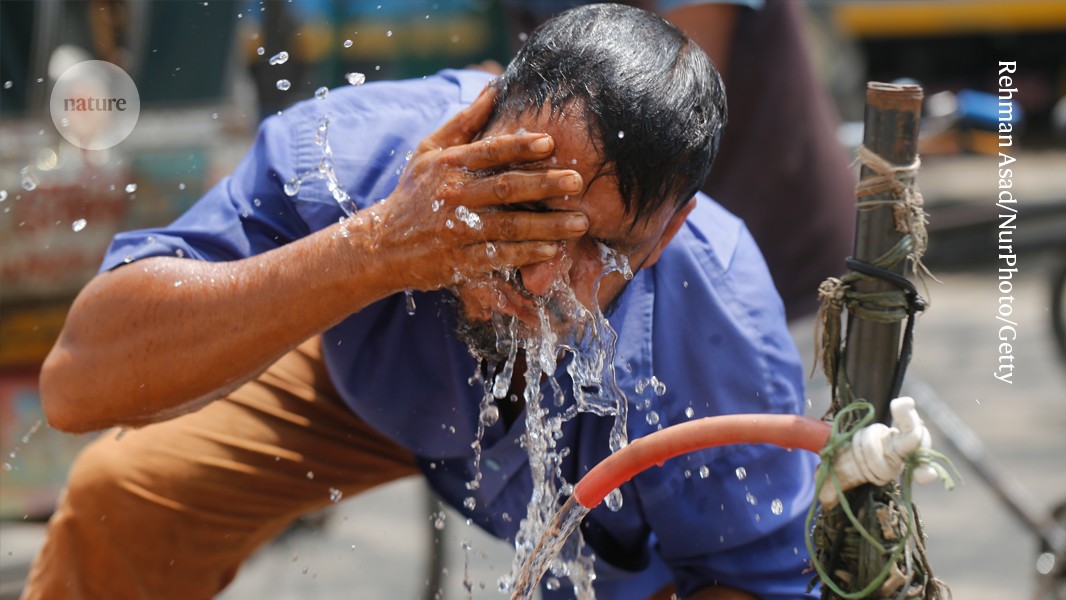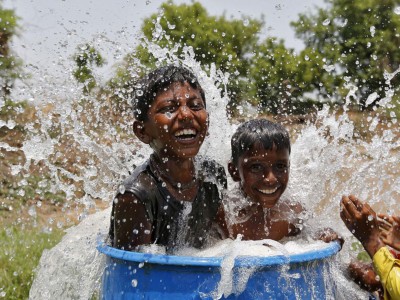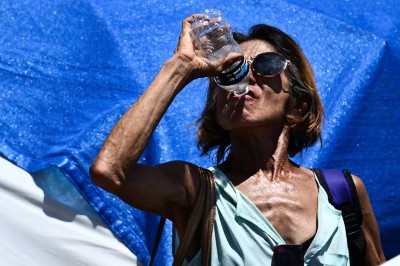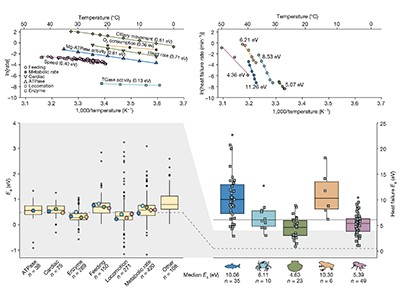This story is part of special report on science and extreme heat. Read about the effects that extreme heat has on the body, how climate change is intensifying health problems, and the record-breaking warming at the Great Barrier Reef.
In 2019, physiologist Ollie Jay started designing a chamber that could simulate the heatwaves of today and of the future. Eighteen months later, the Aus$2-million (US$1.3-million) structure was built, packed up in Brisbane, Australia, and driven 1,000 kilometres to the University of Sydney, where it was lifted to the top floor of a shiny glass building. Now, researchers including Jay are using it to test the limits of human survival in extreme heat, which are surprisingly poorly understood.
Cities must protect people from extreme heat
“The trouble is that, today, you have these conditions that can sound hot, but we don’t really know what it’s going to do to people,” says Jay, who directs the heat and health laboratory at the University of Sydney. “By simulating those conditions and exposing people to them, under careful medical supervision, we can better understand the physiology of how people will respond,” he says. Jay’s team is also exploring which cooling strategies work best to reduce the health risks of heat exposure.
As climate change heats the Earth, blistering days have become a regular feature of weather reports worldwide. Last month, the record for the world’s hottest day was broken twice, and the United Nations made a global call for action on extreme heat, to help vulnerable people, workers and economies to cope using science. Around 70% of the global workforce — 2.4 billion people — are now at high risk of extreme heat, it said.
Despite this, public advice on how to cope with high temperatures is poor, and ways that people can effectively cool themselves have not been well studied. “If you look at heat advisories from well-respected organizations like the US Centres for Disease Control and Prevention, the World Health Organization, they’re fraught with errors when it comes to human physiology,” says Larry Kenney, a physiologist at Pennsylvania State University in University Park.
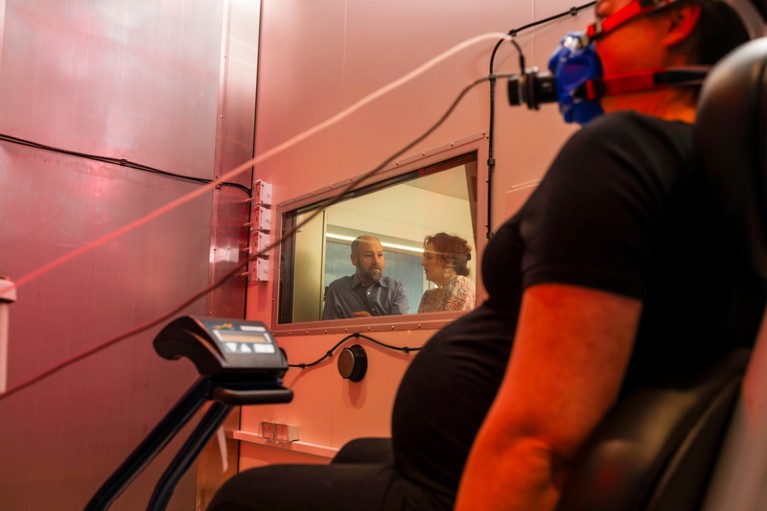
Researchers at the University of Sydney monitor how heat is affecting a pregnant woman in their climate chamber.Credit: University of Sydney/Stefanie Zingsheim
Chamber of heat
Jay’s team is using its state-of-the-art climate chamber to investigate the conditions under which heat threatens life, how, and what practical, evidence-based ways there are to stay cool.
The chamber is a room 4 metres by 5 metres. Researchers can dial the temperature up or down by 1°C every minute — from 5 °C to a searing 55 °C — control windspeed and simulate sunlight using infrared lamps. They can also fine-tune humidity, a key variable that influences heat’s effects on the body. “It’s quite the engineering feat,” says Jay.
Extreme heat harms health — what is the human body’s limit?
Trial participants can eat, sleep and exercise inside the chamber; researchers pass food and other items to them through a hatch. Sensors attached to them send information to the adjacent control room, which processes data on variables including heart rate, breathing, sweating and body temperature.
Heat thresholds for humans have been poorly defined in part because public-health bodies have over-relied on a theoretical study published1 in 2010, says Jay. In that paper, researchers used mathematical models to define the ‘wet-bulb temperature’ (WBT) at which a young, healthy person would die after six hours. WBT is a measure that scientists use when studying heat stress because it accounts for the effects of heat and humidity.
The models churned out a WBT of 35 °C as the limit of human survival. At that threshold, the body’s core temperature would rise uncontrollably. But the model treated the human body as an unclothed object that doesn’t sweat or move, making the result less applicable to the real world.
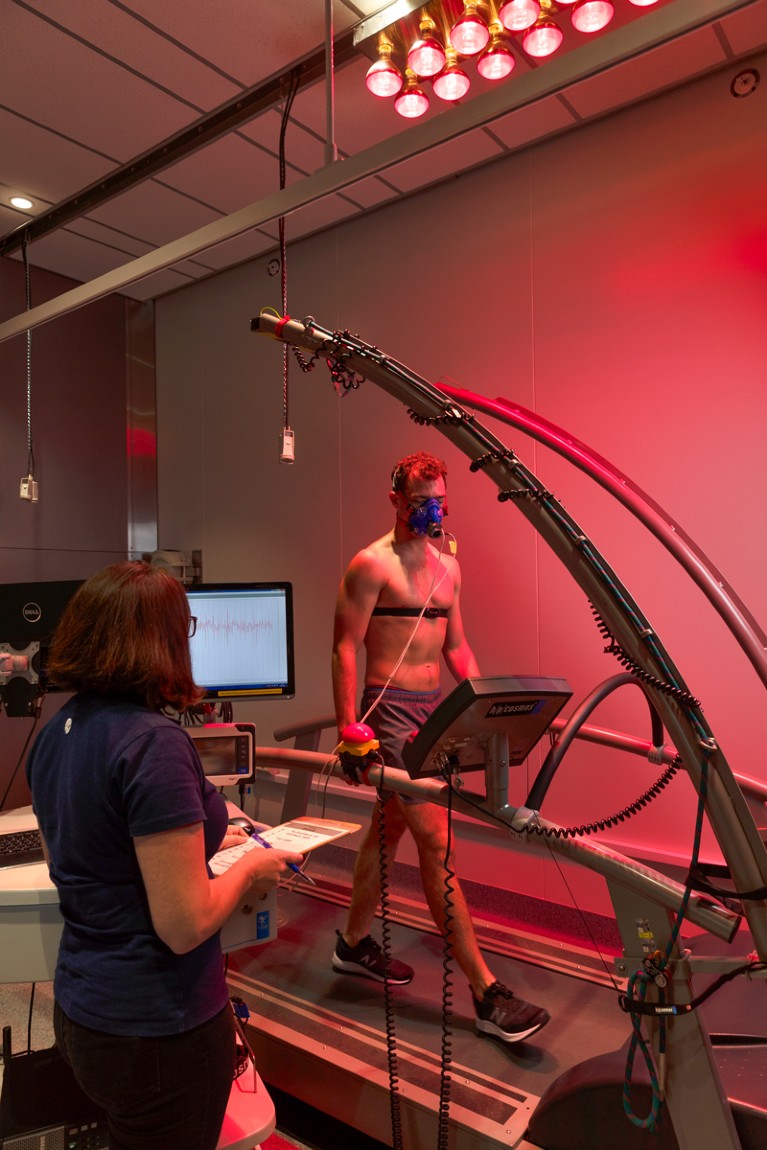
Ollie Jay’s lab is studying how heat affects people who are exercising to mimic everyday activities.Credit: University of Sydney/Stefanie Zingsheim
Despite this, countless public-health bodies adopted it — even the Intergovernmental Panel on Climate Change — reducing the motivation to obtain a more relevant number, says Jay. “It’s a basic physical model with many limitations — but nearly everyone’s using this.”
Lowered limit
In a 2021 study, Kenney and his colleagues provided a better estimate: a WBT survival limit of around 31 °C. They calculated it by tracking the core body temperature of young, healthy people under different combinations of temperature and humidity while they were cycling.
“You do still see the 35 °C wet-bulb temperature tossed around, but people are starting to come around to the limit defined by Kenney’s lab,” says Robert Meade, a heat and health researcher at Harvard University in Cambridge, Massachusetts.
Kenney’s group also works with a climate chamber, and there are dozens worldwide, many dedicated to sports science. But Kenney says that just a few groups, including Jay’s, are at the forefront of using them to better understand how people cope in extreme heat.
Physiological model
Jay’s team is now testing a mathematical model of how the body copes in extreme heat, which it published3 last year. The model uses data from studies that have measured sweating capacity in older and younger people, and it follows physical laws to predict how heat is transferred between the body and environment.
“The fact that they incorporated physiology, which very few models do, and do well — I think this makes it the best model right now out there,” says Kenney, who has collaborated with Jay on other research.
Most models of the body’s response to heat focus on young, healthy people in the shade. But Jay’s team’s model estimated the limits of survival in the shade and sunlight across ages and while people were resting or exercising. Among their results, they estimated WBT survival limits of between 26 °C and 34 °C for young people and 21 °C to 34 °C for older people.
“The flexibility and the ability to very easily assess these different scenarios is the key advance of the model,” says Meade.
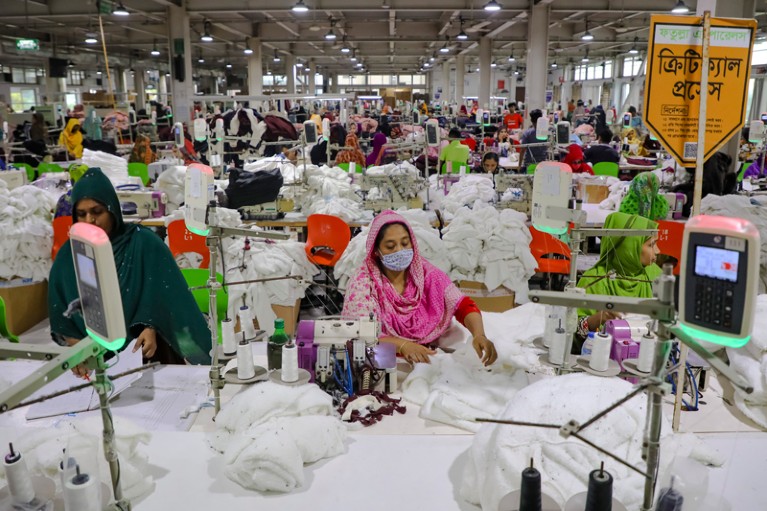
Workers in a garment factory in Bangladesh, where long hours and hot weather can affect employees’ health.Credit: Kazi Salahuddin Razu/NurPhoto/Getty
Unsurprisingly, the model suggests that survival limits are lower when people are exposed to the Sun versus in the shade, and for people older than 65 years old compared with those aged 18–40. The team also used the model to define livability limits — conditions in which older and younger people could safely carry out tasks such as desk-work, walking, climbing stairs, dancing and heavy lifting. Despite its strengths, the model still needs to be tested further in people, says Meade.
To do this, Jay’s team is first exposing young, healthy people in the climate chamber to combinations of temperature and humidity while monitoring variables such as their core body temperature, heart rate and sweating up to a temperature threshold above which it would be unsafe.
Read the paper: Extreme escalation of heat failure rates in ectotherms with global warming
In future trials, the researchers plan to test the body’s response to heat in shady and sunlit conditions, across ages and during exercise. They will use data from these trials to improve the model, which, in turn, can be used to develop better health advice for people most at risk in high heat.
Need to chill
The lab’s other focus — finding effective cooling strategies — involves mimicking the conditions of environments where heat can affect workers’ health. In one trial, Jay’s team is testing cooling strategies that could help garment-factory workers in Bangladesh, where people typically work long hours in hot climates, with little access to air conditioning.
The researchers previously measured the heat and humidity across three floors of a clothing factory in the capital, Dhaka. “We recreated those conditions in the chamber, and the work that people did — the women did sewing and the men did ironing,” he says. The trial participants wore clothing that workers would typically wear in the factory.
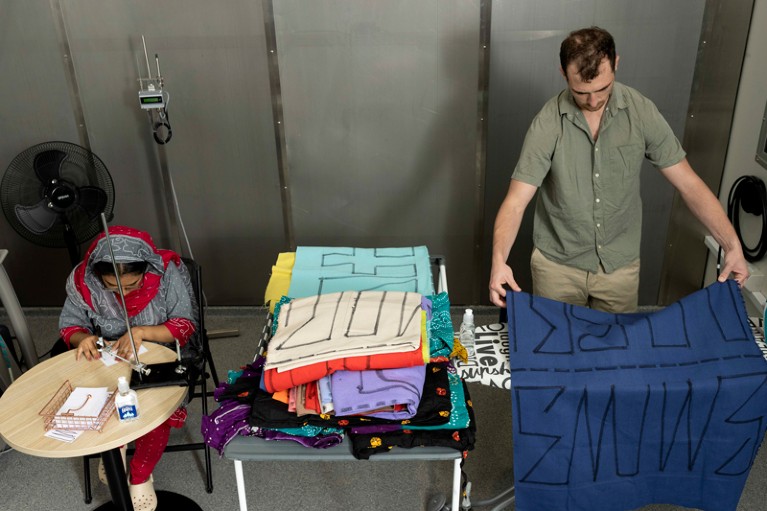
Participants in Jay’s lab have recreated the conditions of a garment factory in their climate chamber to investigate effective cooling methods.Credit: University of Sydney/Stefanie Zingsheim
Across some 240 climate chamber trials, the team measured people’s body functions and their work productivity, says Jay, “because one of the problems is that people slow down when they get hot”. The scientists tested cooling methods such as using fans and regularly drinking water, and simulated the effects of changing the colour of the factory roof. The researchers plan to submit their results to a journal.
Jay’s team has also explored how electric fans and skin-wetting affect heart strain in older people, across different combinations of heat and humidity. The researchers found that, in humid conditions, fan use reduced heart strain up to an air temperature of at least 38 ˚C. But in dry heat, fan use increased heart strain. Wetting the skin was beneficial in both dry and humid heat.
“Identifying the situations in which common cooling strategies, such as fan use and dousing the skin with water, work best is essential to protect public health,” says Meade.
Low-tech cooling
Jay and his colleagues have already popularized a method for cooling babies in prams. “On a hot day, people are covering their baby strollers with these white muslin cloths — but there’s all this contention as to whether it’s a good or bad thing,” he says. In a 2023 study4, the team found that a dry, white muslin cloth can heat up prams by more than 2.5°C, but a damp one had the best cooling effect. “It extracts the latent heat energy from inside the pram and keeps it cooler by about 5 °C,” he says.
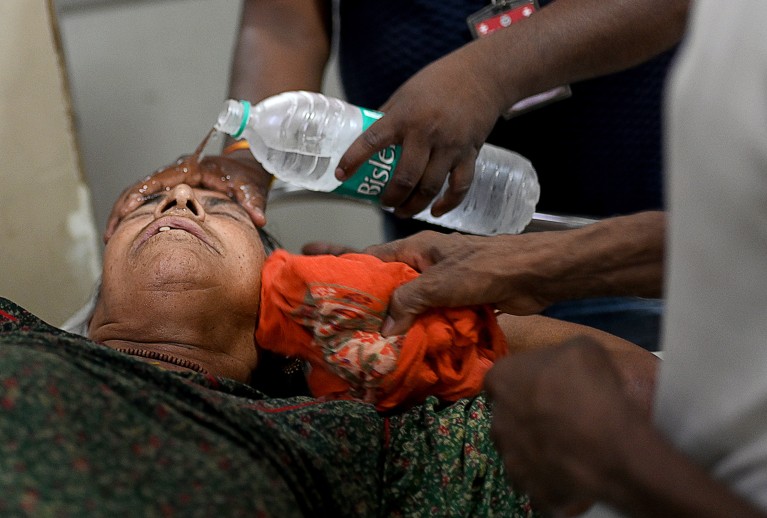
A man is treated for heatstroke in Varanasi, India, which has been experiencing periods of severe heat since May.
The study drew media attention. “What was pretty cool is, two weeks later, I’m walking around where I live and I start seeing parents pushing along their white muslin cloths with a spray bottle,” he says.
The team has also helped to shape a global heat-alert system released by the Google Chrome browser for its users worldwide. “If it knows where you are, and the heat exceeds a certain threshold, then you get an extreme heat warning,” he says. The alert provides cooling tips such as to drink one cup of water per hour and to wet skin and clothing.
Next year, Jay’s lab will track how heat affects birth outcomes and maternal health in pregnant women in Bangladesh. He’s seeking funding to conduct a randomized controlled trial of cooling strategies in India during the hot season.
Jay’s ultimate goal is to protect people’s health in a world that’s becoming ever more hostile. “When I first came over to Sydney, I basically took a big demotion — there was an old chamber that wasn’t really working well, and I had about Aus$16,500 of start-up funding,” says Jay. “We have been lucky and fortunate to be able to bring in some good funding, and make some good traction in this area.”


